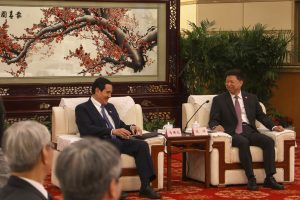Former Taiwanese President Ma Ying-jeou visited China late last month, where he met with Song Tao, the director of China’s Taiwan Affairs Office of the State Council of the Chinese Communist Party (CCP). In Nanjing, Ma said that Sun Yat-sen’s ideals have been realized in China and Taiwan, while in Wuhan, he proclaimed that Wuhan’s COVID-19 measures have contributed to humanity.
In Taiwan, support for Ma’s words and actions in China is all but absent. Taiwanese voters may in fact now be feeling that Ma has shown his true colors with his pro-Chinese statements. This is in stark contrast to current President Tsai Ing-wen’s “private” stop in the United States, which was taking place at the same time. If Taiwanese voters turn their gaze to the Kuomintang (KMT), then Ma’s visit to China won’t work in his favor in the January 2024 presidential election. With around 50 percent of Taiwanese voters favoring the status quo and about 30 percent leaning somewhat towards independence, Ma’s actions appear excessively pro-China. They are likely too much even for those who think Taiwan should strike a balance with China. Of course, there are also those who say that Tsai’s visit to the United States has exacerbated tensions in the Taiwan Strait, but that is primarily a KMT narrative.
So what is it that the former Taiwanese leader hopes to accomplish? Ma served as Taiwan’s president from 2008-2016. In November 2015, six months before the end of his term, he met Chinese President Xi Jinping in Singapore. As Rana Mitter notes in China’s Good War: How World War II is Shaping a New Nationalism, China focused on the KMT up until the 70th anniversary of the victory of the Second World War and the victory of the War of Resistance Against Japanese Aggression in September 2015, maintaining the basic line known as the “First United Front” with the KMT as its Taiwan unification policy. That is why the historical interpretation followed the mainstream narrative that the First United Front was formed at least after the Xi’an incident in 1936, with the KMT and the CCP defeating Japan together.
However, the situation has changed markedly since then. In China, the Taiwan line is no longer one of collaboration with the KMT but has shifted to a “benefit Taiwan” policy of directly influencing Taiwan society and benefitting Taiwan, and it has produced some results. The historical interpretation has also changed significantly, and through the creation of a historical narrative centered on CCP history, the Sino-Japanese War period now means the 14 years after 1931. Consequently, the First United Front has receded into the background and the CCP’s war against Japan has the stage. Exchanges and cooperative projects between researchers of modern Chinese history on both sides of the Strait have also receded rapidly.
China is currently putting pressure on Taiwan, bolstering its military power while infiltrating the gray zone and economic sanctions. Beijing’s aim is to get Taiwan to abandon the status quo and independence, and ultimately force a “peaceful” reunification. The KMT’s position in this broader strategy is unclear. Ma’s visit to China may reflect an intention to once again revive the First United Front, meaning the line adopted in Singapore in November 2015, ahead of the election in January 2024. Cross-strait relations based on the 1992 Consensus and the line of CCP and KMT collaboration won’t necessarily mean “unification.” However, it is more clearly aimed at a cooperative way forward with China than the stance chosen by the Democratic Progressive Party. But will China really respond to Ma’s move? The former Taiwanese president made statements favorable to China in both Nanjing and Wuhan, and when he met with Song Tao, he did not speak freely but read a text out word for word. It was a performance that seemed to be prepared for the possibility of meeting someone else of Song’s rank or higher.
Yet Ma’s visit to China and his associated words and actions will also serve as a major constraint for the KMT candidate in the presidential election. For Hou Yu-ih (the mayor of New Taipei City), who is reluctant to run for office due to term issues but enjoys great popularity, the overall framework will already have been set by Ma even before he gets to talk about the cross-strait policy, while First United Front ideas might not be shared with native Taiwanese members of the KMT. Voters’ views on China today, in the wake of the COVID-19 pandemic and Russia’s invasion of Ukraine, are also very different from what they were in 2015. Ma is likely hoping to revive the course he himself set out in November of that year, namely the First United Front line, but is that really what voters want? Anyway, China may not be pursuing that line anymore. The effectiveness of the visit very much remains an open question.
KAWASHIMA Shin is a professor at the University of Tokyo.

































